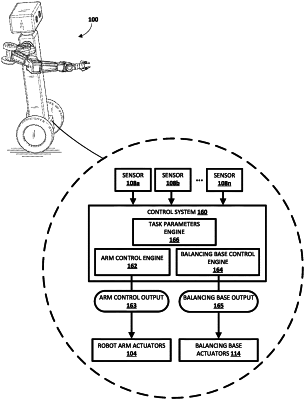| CPC B25J 5/007 (2013.01) [B25J 9/1633 (2013.01); B25J 13/085 (2013.01); B25J 13/088 (2013.01)] | 20 Claims |

|
1. A method performed by one or more processors of a robot, the method comprising:
determining, based on a robotic task being performed by the robot, that a current world frame end effector pose, of an end effector of the robot, is to be maintained for a plurality of control cycles,
wherein the current world frame end effector pose is relative to a world frame,
wherein the current world frame end effector pose, of the end effector, is a function of a robot arm pose, of a robot arm of the robot, and
wherein the robot arm pose, relative to the world frame, is controlled in part by a plurality of arm actuators of the robot arm and in part by one or more wheel actuators that each drive a corresponding wheel of a base of the robot;
receiving, during one or more of the control cycles, sensor data that indicates a disturbance to the base of the robot;
in response to receiving the sensor data that indicates the disturbance to the base, and in response to determining that the current world frame end effector pose is to be maintained for the plurality of control cycles:
generating arm control output based on the sensor data and the current world frame end effector pose,
wherein the arm control output is generated, in view of the disturbance to the base, to adjust one or more of the arm actuators to maintain the end effector in the current world frame end effector pose; and
providing the arm control output to adjust the one or more of the arm actuators, wherein the arm control output causes a robot frame end effector pose, of the end effector relative to a fixed reference point of the robot, to be adjusted, while maintaining the end effector in the current world frame end effector pose.
|